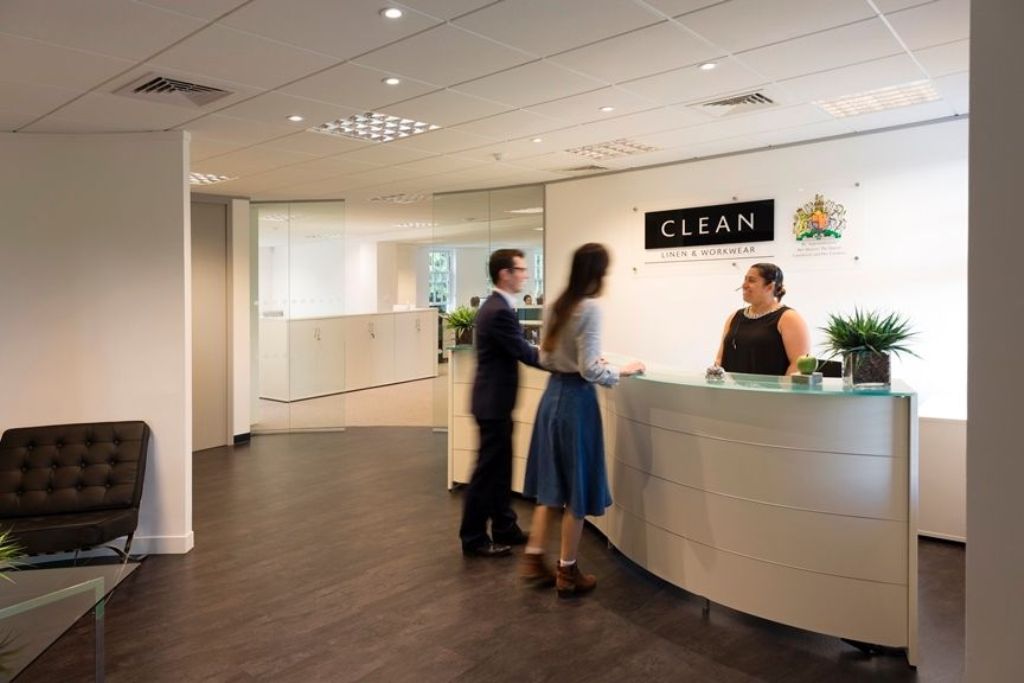Learning
A Comprehensive Guide on How to Design a Reception Area

In its most basic form, a reception area is a section of your office space created to greet all visitors and provide a waiting area for them until they meet the person they came to meet with. It is the first area employees, clients, and potential prospects see when they walk into an office. You can also say that the reception area acts as the initial professional point of contact.
We have all heard the expression “first impressions count,” and it certainly applies to office spaces as well. After all, a good first impression creates a great lasting impression, isn’t it? That is why many offices invest a reasonable amount of time and effort into creating a well-presented reception area.
From meeting new clients to interviewing prospective employees, maintaining the right balance between interior design and furniture alignment in the reception area can make all the difference in creating new- as well as maintaining existing- business relationships.
Consider this, no matter how great your company is or how familiar the customers are with your brand, if the front of your business looks scruffy, then it is bound to put potential clients off. Thus, when designing a reception, you’d want to make sure it will cater to the needs of your company, as well as the values of your brand. Therefore, you should aim to create an elegant, beautiful and comfortable space that accurately embodies your company’s tone when it comes to receptions.
The Elements of a Welcoming Reception Area
Having a clear picture of what you want it to look like helps. Are you aiming for a modern, minimalist look or a more traditional and sophisticated ambience? Check everything down to the details, as you can see in stores like Freedman’s Office Furniture.
Here’s a breakdown of all the elements you need to cover to create the ideal reception area:
The Right Size
The size of the reception area tends to be in direct proportion to both the type and size of your business. For instance, If you have a large business with many employees, then the reception area can reflect that through its size.
Likewise, if you have a relatively small business with not many employees, your reception area can also be relatively small. Take the reception halls at Google’s office, for example. Large companies tend to generally have relatively large reception areas styled according to their business brand.
The sophistication and the associated cost of building a stylish reception area versus a basic one will also largely depend on how the business runs. Again, taking Google’s reception area as an example- you can clearly decipher that Google is a large business that can afford expensive, building cosmetics and furniture styles. Compare that to other reception areas in relatively smaller businesses, like your local dentist’s office, for instance.
Nevertheless, most reception areas have several furnishings and components in common, such as:
- Appropriate receptionist desk/station
- A comfortable and ergonomically appropriate receptionist chair
- Waiting chairs for guests
- A reception desk
- Visitor tables
The reception area’s layout is also especially important as it reflects how the rest of the company is set up. The key is to have an easy layout that visitors won’t have trouble navigating in. You can create a natural flow depending on how much space you have to work with, leading visitors from the elevator or door to the front desk and subsequently to the seating area without any obstacles on the way.
Correct Seating Arrangements
While designing a comfortable reception area, take a step back and view your waiting area from an outsider’s perspective. Better yet, you can even ask a friend to visit. Ask these questions:
- Are the chairs comfortable? A little bit of soft cushion goes a long way when a client is waiting.
- Are there enough chairs? It is always best to plan for more than what may be needed to ensure a guest is never left standing.
- Are there chairs available for clients of all sizes? You can consider adding chairs with no arms to give everyone equal comfort.
- Are the fabrics for your seat clean and/or easy to clean? There is nothing less professional than big stains; it makes the area look bedraggled. For this, vinyl or tight-weave fabrics can save the day.
Homely Reception Area
Your reception desk is the focal point of your company’s waiting area. For best results, the desk should give your staff enough space to do their job efficiently while also keeping clutter under wraps and out of sight.
Things to consider when choosing a reception desk:
- If your receptionist needs to conduct private phone calls frequently, a floor-to-ceiling glass divider can keep conversations confidential, while a half-height divider around the desk allows for privacy, albeit limited. It also keeps the space more open and inviting.
- If your receptionist needs to use a copier, filing cabinet, or other office supplies regularly, organizing the equipment near the reception space will ensure that your staff is never too far away to miss someone’s arrival.
The Right Colours
Take a moment to think about how different colours affect you. Bold reds, fiery oranges, and blinding yellows may feel agitating in a small closed space. What would a wild purple or hot pink communicate? What about soft pastel blues? A muted smoky grey?
Remember- the reception isn’t about your personal favorites, but more about reflecting trust and professionalism towards your clients and customers. You can try choosing softer, more neutral colours and inject some personality through wall art, elegant pillows, or rich rugs.
Bright Lighting
If you are fortunate enough to have a reception area with streams of natural light flowing in, you can definitely capitalize on it! It is best to keep shades or remote control roller blinds to a minimum. If you are in a darker space, you should consider choosing soft lighting from table lamps or wall fixtures. For the most part, overhead fluorescent bulbs can feel sterile and unwelcoming. Instead, why not try LED lighting for a more natural feel? Overall, be sure there is plenty of light in your space for it to feel warm, clean and for your waiting clients to be able to read and feel relaxed easily.
Suitable Accessories
Have a walk through your space. While doing so, consider small touches that can add comfort. For instance, adding a coat rack or preparing a space to hang jackets or wet umbrellas can make a huge difference. Ensure that there are enough surfaces, such as end tables or coffee tables, for your clients to set down beverages, project folders, or even handbags.
You can also keep up the welcoming atmosphere with bottled water, a bowl of mints, fresh tissues, and fresh reading materials. Also, use air fresheners or fresh flowers sparingly as they might cause allergic reactions from guests. Finally, for an added je ne sais quoi, you can also frame a handful of awards or media clippings about your work and hang them in the reception area for your clients to read or see.
Astute Technology
Sitting in a reception area with nothing to do is not only boring but also unproductive. For this, you can set up a computer terminal or grant guest Wi-Fi access. With this, you will allow clients to quickly check emails or read the headlines. A mounted television, as is the case in most reception areas, is also a great option. If you expect to have children in your reception area, consider creating a small activity area for them.
If the Reception Area is at a Hospital/Medical Center
Typically, a medical office reception area tends to have many chairs to accommodate a number of waiting patients. A good reception area should also be accommodating to differently-abled patients or patients with special needs.
There should be special attention to details, such as the width of doors and ease with which patients in wheelchairs can access the reception area safely and independently. Likewise, the counter’s height, where the individual with special needs will be addressed, is also important.
Many medical office reception areas are also designed with an adjacent restroom. Appropriately placed restrooms near the reception area allow ease of access, and the same preparations should be considered for differently-abled or special needs patients.
Similarly, if the medical office caters to children, such as a pediatrician’s office, there should be suitable child decorations and play items for young patients. Cranky children require many distractions to keep them busy.
If the Reception Area is also a Retail Location
If your office is also a retail location, there will likely be a retail display need. It depends on the size of the business. In this case, consider how to ensemble the reception area to make it conducive for visitors to be tempted to purchase products.
A health and wellness business such as a barber, a beauty salon, or a spa is typical examples of reception areas with retail products to sell. Importantly, when building a reception area, one of the main things to consider is whether or not there is a necessity for installing cameras.
It is recommended that there be a camera or two aimed at both the retail areas as well as the receptionist, particularly if there is a retail display area. Many effective, low-cost camera solutions allow DVR (Digital Video Recording) from cameras placed throughout the business, including the reception area.
How Does Your Reception Area Make an Impression?
As mentioned, you have one chance to make a first impression when visitors enter your office for the first time. In the case of VIP visitors, such as prime job candidates or potential clients, it is especially important to nail it perfectly. When visitors walk in, the front office should present them with an idea of your company’s priorities and personality. That impression can then pave the way nicely for conversations and job interviews that will follow.
Additionally, you also need to be clear about your reception area’s mission. What is the exact message you’re trying to communicate with your reception area? For most companies, the message ties in with your company’s brand. For example, if you have branded your company as fun and vibrant, your front desk’s mission should be to energize and inspire everyone who walks in.
Similarly, if the most important thing for your company to project is a sense of expertise and professionalism, the main purpose of the front desk should be to evoke feelings of trustworthiness, efficiency, and competency. Furthermore, if you are a luxury brand, you might want your reception to make a distinctive statement to surprise posh visitors.
It is not always easy to encapsulate the mission of your front desk in a concise statement. But you can think a little more about who will be coming into your reception area and what will make them feel comfortable. As such, being aware of key details contributes to building a remarkable first impression when it comes to your reception area. The details generally fall into three main categories-
Design
Whether you are designing for a small start-up company or a big firm, you want the reception area to feel elegant and clean. Elegant doesn’t necessarily mean overly fancy or extravagant- it simply means space should be both stylish and pleasant.
Beyond everything, there is a lot of traffic that passes through the reception area. An outdated or bland reception area design can negatively impact the mood of employees, clients, and other visitors. Avoid this by designing a warm and welcoming environment.
Speaking of design, most small companies can’t afford to allocate a substantial amount of money to pay for a big, airy reception area. Nevertheless, even in small spaces, you can still do several things to make the area more calming and spacious. You can start by removing any clutter for a cleaner look. For a small space, downsize the furniture (think sleek, modern chairs instead of big fluffy ones). Outside of design, you can also make sure guests aren’t kept waiting for long, so there’s little chance of making it crowded.
Correspondingly, if your space is minimal, you might not even need a full desk in the reception area. You can have guests check-in via a mounted tablet using a visitor management app like The Receptionist. Customize who gets alerted when visitors arrive and how they get alerted (they can even choose custom intervals). You can also set backup contacts in case the first contact doesn’t respond.
Another factor to consider while designing a reception area is changing the colour of your front office area. It is one of the least expensive ways to experiment with the energy you want to project with the reception area. Similarly, graphics, decor, and accessories all go a long way towards pulling your reception area’s look together. They can complete the statement you want your company or office to make.
For this, there’s no one way to do this; you can play with the line elements, the form, texture, and even the pattern to create a cohesive style that suits the area the best. To create a relaxing vibe, you can even add a beautiful live plant to the front desk (or, to take it a step further, a vertical garden).
Staff
A big part of your front office style has a lot to do with the person sitting behind the front desk, including their appearance and behaviour. It’s worth mentioning that your receptionist should also follow your company’s brand when it comes to the presentation. A casual and hip tech startup might not go for a receptionist in a buttoned-up shirt with a tie and blazer, for example.
The opposite might be true for the receptionist of a high-billing service like a legal office or a luxury brand headquarters. Be sure to note in the job description for your receptionist that a professional appearance (whatever that means for your company) will be required. Identically, most companies don’t have enough visitors to dedicate someone solely to visitor management. Thus, front desk workers are often responsible for other administrative or executive tasks as well.
Visitor Check-In Process
The tools you use for the visitor check-in process is the final piece of the puzzle when it comes to your reception area, making a great impression. For example, a paper sign-in log sends the message that your company may be traditional or perhaps old-fashioned. If you want your company to look modern and competent, you may want to switch to digital processes instead.
Final Consideration
If your business is a franchise, it’s always best to follow the franchisor’s recommendation as a guide for building the reception area. One of the advantages of buying a franchise is harnessing the franchisor’s years of experience in creating structures that will enable a business to succeed. The material you use for your reception’s design also plays a huge role.
Make sure you use durable and appropriate materials for your reception desk, chairs, and other accessories. For the best office furniture, you can check out Direct Office. Contact Us at any time for any queries, or simply remember us for the best furniture for all occasions or requirements.

Learning
First-Time Buyer’s Guide to the UK Property Market

Entering the UK property market as a first-time buyer can feel both exciting and daunting. The process is filled with potential pitfalls and complex decisions, but with the right guidance, it can be navigated smoothly. The estate agents in Yorkshire demystify the journey from the initial decision to buy a home to the moment you step over the threshold of your new property.
Understanding Your Financial Position
The first and perhaps most crucial step in the home-buying process is understanding your financial situation. This includes assessing your savings, income, and current debts. Here’s how you can prepare:
1. Deposit: Generally, you’ll need at least 5% of the property price as a deposit, though aiming for 10% or more can provide better mortgage rates.
2. Income and Expenses: Use a budget planner to assess your monthly income against your expenses. This will help you understand how much you can afford in monthly mortgage repayments.
3. Credit Score: Lenders will evaluate your credit score to determine your mortgage eligibility. So it’s important to have a good credit score, and you should work on it if required.
4. Mortgage Options: Speak to a mortgage advisor to understand different types of mortgages, such as fixed-rate, variable-rate, and help-to-buy schemes.
Getting a Mortgage Agreement in Principle
A Mortgage Agreement in Principle (AIP) is a statement from a lender indicating how much they’ll likely lend you. You will be a more attractive buyer with an AIP as it shows sellers you’re serious and financially prepared.
Deciding What You Want
Before you start viewing properties, it’s essential to know what you’re looking for. Consider the following factors:
1. Location: Proximity to work, schools, public transport, and amenities are key. Research neighbourhoods to find the best fit for your lifestyle.
2. Property Type: Decide whether you want a flat, terraced house, semi-detached, or detached property. Each has its pros and cons.
3. Must-Haves: Make a list of non-negotiables, such as the number of bedrooms, garden size, and parking facilities.
4. Future Proofing: Consider your future needs. Are you planning to start a family? Do you need space for a home office?
Starting the Property Search
With a clear idea of what you’re looking for, you can begin your property search. Here are some tips:
1. Use Online Portals: Websites like Rightmove, Zoopla, and OnTheMarket are excellent starting points. Set up alerts to get notified of new listings that meet your criteria.
2. Visit Estate Agents: Register with local estate agents who can provide insights into the market and inform you of new properties before they’re listed online.
3. Attend Viewings: Don’t rush this part. Visit several properties to get a feel for what’s available in your price range.
Making an Offer
Once you find a property you love, it’s time to make an offer. Here’s how to approach it:
1. Research: Check the selling prices of similar properties in the area to gauge a fair offer.
2. Negotiate: Don’t be afraid to negotiate. The starting point is most usually the asking price.
3. Conditions: You might include conditions in your offer, such as the inclusion of certain fixtures or a specific moving date.
The Legal Process
If your offer is accepted, the legal process begins. You’ll need a solicitor or licensed conveyancer to handle the legalities. Here’s what to expect:
1. Conveyancing: This is the legal transfer of property ownership. Your solicitor will handle this, including conducting searches, dealing with the Land Registry, and transferring the funds.
2. Surveys and Inspections: Arrange for a property survey to check for structural issues. There are different types of surveys, from basic condition reports to full structural surveys.
3. Mortgage Finalisation: Once the survey is complete and satisfactory, your mortgage can be finalised.
4. Exchange of Contracts: This is when the sale becomes legally binding. You’ll pay your deposit at this stage.
5. Completion: On the agreed completion date, the remaining money is transferred, and you receive the keys to your new home.
Moving In
Moving day can be hectic, but planning can ease the stress:
1. Hire a Removal Company: Book a reliable removal company well in advance. Discover the best deals by getting quotes from multiple companies.
2. Pack Strategically: Label your boxes by room and keep essential items accessible.
3. Notify Utilities and Change Address: Inform your utility providers of your move date and update your address with banks, the DVLA, and other important institutions.
Settling In
Get settled. Introduce yourself to the neighbours, familiarise yourself with the local area, and really start to make the place your own.
Here are a few final tips:
1. Safety Checks: Make sure that your smoke alarms and carbon monoxide detectors are working, and make sure that you know where the gas and electricity meters are located.
2. Maintenance Plan: Keep a record of the smooth functioning of your new home with a maintenance schedule, complete with regular checks and seasonal tasks.
3. Personal Touches: Add personal touches to make the space feel like home. This can be from putting up family photos or redoing the decoration in your rooms.
Conclusion
Buying your very first home in the UK is most definitely a milestone, difficult and full of challenges but rewarding in the end. Such a philosophy guides you in understanding finances and knowing what you want to achieve from detailed research, and seeking professional advice that confidently helps you navigate the property market. Yes, the journey may have its hurdles, but in the end—owning your own home—the reward will be worth the effort. Welcome to your new chapter!
SEE ALSO: Conquer the Chaos: Hacks to Clean Your Home in Half the Time
Learning
5 Health Benefits of Regular Pedicures

There’s nothing quite like a pedicure to keep your feet looking and feeling their best, but did you know that pedicures do more than simply enhance the appearance of your feet? Many people don’t realize that regular pedicures can come with a wide range of health benefits that can promote the well-being of your feet, so here are some ways that your routine pedicure keeps both your toenails and feet in the best condition possible!
Smoother Skin
One of the biggest misconceptions about pedicures is that they only cater to and look after your toenails. While you’ll definitely be leaving each session with a fresh coat of nail polish, your pedicure can also do wonders for the health of your skin. Aside from trimming and shaping your nails and cuticles, you’ll notice that your nail technician also dedicates a few steps to the skin of your feet.
After inspecting your feet and looking for any issues or imperfections that may need to be addressed, your technician will work on an exfoliating scrub to remove any dead skin cells. This step may also be aided by a foot file, which can be used to buff away any calluses and other problem areas manually.
Softer Skin
After your nail technician addresses all the problem areas of your feet and removes any unwanted dead skin cells, he or she will often massage in a moisturizing product, such as lotion, cream, or butter, to ensure that your skin is properly moisturized. These products contain skin-loving ingredients that will ensure that your feet have everything they need to look and feel their best so that you can walk out of your pedicure with a renewed sense of confidence.
Healthier Nails
After your pedicure session, your nails will not only look better due to the fresh coat of nail polish, but they’ll also be healthier and stronger. This is because your nail technician takes their time to ensure that your nails are properly looked after through steps that include deep cleaning, nail trimming, nail filing, and cuticle care. All of these things work together to prevent issues like ingrown nails from occurring, all the while improving the appearance of your nails.
Increased Blood Circulation
While the specific steps included in your pedicure will depend on the beauty salon, most pedicures will have a massage step somewhere in the mix. One of the often overlooked benefits of these massages is the increased blood circulation, which can deliver more nutrients and oxygen to your feet and nails, promoting their health and appearance. Aside from that, better blood flow means reduced tension and soreness, as well as better distributed heat throughout your body.
Reduced Infections
A significant amount of dirt and bacteria can build up on your feet without you even realizing it, but pedicures can be a great way to prevent these from happening in the first place. The exfoliation step of a pedicure removes dead skin cells as well as all the debris that may have accumulated underneath, and the deep cleaning of your toenails and cuticles also gets rid of any impurities that may have slipped beneath them, which can stop infections from happening.
These are some of the many health benefits that you can look forward to at your next pedicure appointment. However, it’s worth noting that you need to book regular sessions to truly reap all the rewards. This can be difficult, especially when you don’t feel like driving to your nearest nail salon after a long day, but the good news is that you can enjoy the salon experience in the comfort of your own home with a home pedicure service.
Learning
Commercial Boiler Installation Services London

For businesses in the bustling city of London, having a reliable heating system is crucial. Whether you’re opening a new office, expanding your current premises, or simply upgrading an outdated system, commercial boiler installation services for businesses in London are essential to ensure your operations run smoothly and efficiently. Proper installation and maintenance of commercial boilers can make a significant difference in energy efficiency, cost savings, and the overall comfort of your workspace.
The Importance of Professional Installation
When it comes to installing a commercial boiler, professional expertise is paramount. Here’s why:
- Efficiency and Performance: Professional installation ensures that your boiler operates at peak efficiency, reducing energy consumption and lowering utility bills. A well-installed boiler can effectively meet the heating demands of your business without unnecessary energy waste.
- Safety: Commercial boilers are complex systems that require precise installation to operate safely. Professional installers adhere to stringent safety standards and regulations, minimizing the risk of accidents and ensuring the safety of your employees and premises.
- Compliance with Regulations: Commercial properties are subject to various building codes and regulations. Professional installers are well-versed in these requirements and ensure that your boiler system complies with all local laws and standards.
- Longevity and Reliability: Proper installation is critical to the longevity and reliability of your boiler. A professional installation can prevent common issues such as leaks, pressure problems, and system failures, ensuring that your boiler runs smoothly for years to come.
Key Considerations for Commercial Boiler Installation
When planning for a commercial boiler installation, several factors need to be considered:
- Type of Boiler: The type of boiler you choose will depend on your business’s specific needs. Options include gas boilers, oil boilers, and electric boilers, each with its own set of advantages. Consulting with a professional can help you determine the best choice for your business.
- Sizing and Capacity: The boiler’s size and capacity must match the heating demands of your commercial space. An undersized boiler will struggle to meet your needs, while an oversized one will lead to inefficiencies and higher costs.
- Location: The placement of your boiler affects its efficiency and accessibility for maintenance. Professional installers can help you choose the optimal location for your boiler.
- Integration with Existing Systems: If you’re upgrading or replacing an existing boiler, it’s essential to ensure compatibility with your current heating system. Professional installers can seamlessly integrate the new boiler with your existing setup.
Choosing the Right Installation Service

Selecting the right installation service provider is crucial to the success of your boiler installation project. Consider the following when making your choice:
- Experience and Expertise: Look for a provider with a proven track record in commercial boiler installations. Experienced installers can handle the complexities of commercial systems and provide high-quality workmanship.
- Reputation: Check reviews and testimonials from previous clients to gauge the provider’s reliability and customer satisfaction.
- Comprehensive Services: Choose a provider that offers a full range of services, including installation, maintenance, and repair. This ensures that all your boiler needs are met by a single, trusted source.
In London, ROWLEN is a reputable name known for delivering top-notch commercial boiler installation services. Their team of experts is dedicated to providing efficient, safe, and compliant installations tailored to the unique needs of businesses.
Conclusion
Investing in professional commercial boiler installation services for businesses in London is essential for ensuring efficiency, safety, and long-term reliability. By choosing an experienced and reputable service provider like ROWLEN, you can rest assured that your heating system will be installed correctly and maintained to the highest standards. Proper installation not only enhances the performance of your boiler but also contributes to the overall comfort and productivity of your business environment.
SEE ALSO:
-

 News3 years ago
News3 years agoLet’s Know About Ultra High Net Worth Individual
-
Entertainment2 years ago
Mabelle Prior: The Voice of Hope, Resilience, and Diversity Inspiring Generations
-

 Health3 years ago
Health3 years agoHow Much Ivermectin Should You Take?
-

 Tech2 years ago
Tech2 years agoTop Forex Brokers of 2023: Reviews and Analysis for Successful Trading
-

 Lifestyles3 years ago
Lifestyles3 years agoAries Soulmate Signs
-

 Movies2 years ago
Movies2 years agoWhat Should I Do If Disney Plus Keeps Logging Me Out of TV?
-

 Health3 years ago
Health3 years agoCan I Buy Ivermectin Without A Prescription in the USA?
-

 Learning2 years ago
Learning2 years agoVirtual Numbers: What Are They For?